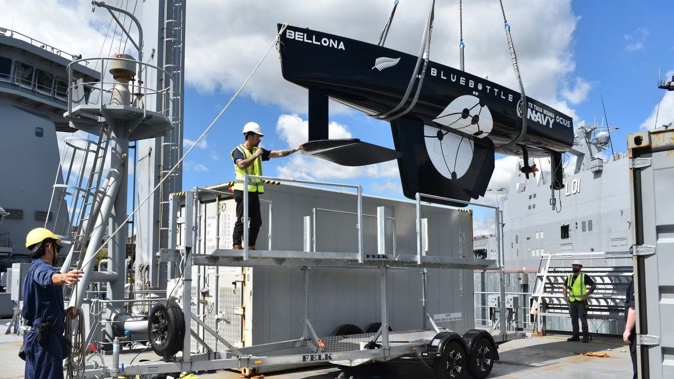
Science fiction became fact this week when the Royal New Zealand Navy took possession of a new craft that can stay at sea indefinitely.
The 6.8-metre Uncrewed Surface Vessel (USV) is powered by renewable energy from the sun, wind or waves and can be used for a range of deployments including fishery protection, border protection or providing meteorological data.
The Navy’s maritime component commander, Commodore Garin Golding, believes the new vessel, dubbed the Bluebottle, will be a useful addition to the fleet that has an enormous Exclusive Economic Zone (EEZ) to patrol.
/cloudfront-ap-southeast-2.images.arcpublishing.com/nzme/3NJA72IM35HERLNYY6UFMYVNZI.jpg)
Navy crew grab a photo with their new boat. Photo / ABIS Jasmine Saunders
“Our EEZ is the fifth largest in the world at more than four million square kilometres,” said Golding. “Coupled with the 30m-square-kilometre search and rescue area that New Zealand has responsibility for, that is a lot of ocean to cover.”
The Bluebottle is designed and manufactured by Sydney-based Ocius Technology, which has already sold several USVs to the Australian Defence Force and worked with the Australian Border Force and other energy and scientific agencies.
“The evidence we’ve seen from our partner militaries overseas is that uncrewed drone aircraft and vessels can provide real value in fulfilling some of these search and surveillance tasks,” Golding said.
Photo-voltaic cells drive the small motor and propellor and a retractable rigid sail provides propulsion from the wind. If it’s cloudy and calm, the Bluebottle even has a nifty flipper and rudder device to use wave energy for forward motion.
/cloudfront-ap-southeast-2.images.arcpublishing.com/nzme/5G7JGP2K6RDD5NHZLAJCWO3IJU.jpg)
The Bluebottle can use solar, wind or wave energy to power its systems. Photo / ABIS Jasmine Saunders
With the USV’s top speed of 5 knots (9.2km/h), Ocius Technology won’t be expecting a call from Emirates Team New Zealand any time soon, but its ability to operate in waves as big as 9m will make the boat an effective tool.
It has radar and electro-optic and infrared cameras and will be constantly monitored and operated from a control room at the Devonport Naval Base.
“The Bluebottle has already undertaken a range of activities in support of the Australian Government for long periods of time without the need for refuelling, recharging or crew respite,” said Commander Andy Bryant, the Navy’s autonomous systems staff officer.
“I’m confident we will see similar benefits from the time we have with the vessel, particularly a better understanding of how to operate and sustain uncrewed vessels, and this will provide a great opportunity to share experiences on the new system with the Royal Australian Navy.”
The Bluebottle is currently on HMNZS Aotearoa, en route to Devonport, and will become a familiar sight for boaties and marine traffic around Waitematā Harbour and the Hauraki Gulf during its seven-month evaluation.
Take your Radio, Podcasts and Music with you









